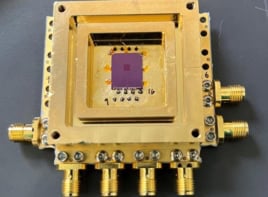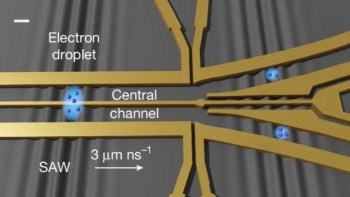
An ultrathin material consisting of two misaligned sheets of graphene can be easily converted from being a Mott insulator to a superconductor. The surprising discovery, details of which were announced at the March meeting of the American Physical Society (APS), could lead to the development of materials with a range of engineered electronic properties.
Graphene is a sheet of carbon just one atom thick that has a wealth of unique and potentially useful electronic and mechanical properties. Graphene atoms are arranged in a hexagonal lattice and two or more atomic layers can be stacked upon each other to create bilayer and thicker stacks of carbon.
In the new work, which is published in two papers in Nature, Pablo Jarillo-Herrero and colleagues at the Massachusetts Institute of Technology, Harvard University and Japan’s National Institute of Materials Science have shown that a graphene bilayer behaves as a Mott insulator when the two component sheets are oriented at a “magic angle”. In this form of matter, electrical conductivity is supressed by strong interactions between electrons. It can then be transformed into a superconductor by tweaking the electron density of the material
The researchers made their material by taking two sheets of graphene and rotating them out of alignment by a small angle of about 1°. Having the sheets at this magic angle creates a moiré lattice of atoms with a unit cell that is much larger than that of a single sheet of graphene. Electrons are localized at lattice sites and, under certain conditions, electrons can tunnel from one lattice site to another.
Each lattice site can accommodate a maximum of four electrons. If the electron density is high and the sites are all full, electrons cannot tunnel to neighbouring sites because there is no room for them – making the material an electrical insulator. However, if the density is lower and the sites are partially full, tunnelling can occur and the material is an electrical conductor.
By varying an electric field that is applied to the magic-angle bilayer, Jarillo-Herrero and colleagues can adjust the electron density of the material. At high density when the lattice sites contain four electrons each, the material is an insulator as expected. At lower densities and temperatures above about 4 K, the bilayer is a conductor – also as expected.
Unexpected insulator
However, something unexpected occurs at lower temperatures when the electron density is set so that each site contains one, two or three electrons. Instead of being a conductor, the material appears to be a Mott insulator – a state of matter that occurs when there is a strong interaction between electrons that inhibits tunnelling. The situation is even more interesting when the electron density is increased or decreased slightly away from two electrons per site. The material then becomes a superconductor with a transition temperature of about 1.7 K, which is surprisingly high given the relatively low electron density of the material.
The combination of a Mott-insulator phase and superconductivity is something that is also seen in some high-temperature superconductors, which tend to be 2D layered materials. As a result, magic-angle bilayers could provide important insights into the poorly-understood physics of these unconventional superconductors.

‘Decorated’ graphene is a superconductor
“Physicists now have an exciting new platform to probe the unusual properties of high-temperature superconductors, and possibly to design new materials that operate at even higher temperatures,” said Jarillo-Herrero at a news conference at the APS March meeting. “Usually you have to grow different classes of material to explore each different phase. We can explore all of the physics in one device electrically. It couldn’t get any simpler.”
Jarillo-Herrero also pointed out that the structures could be used to create devices with a range of useful electronic properties. “One can also imagine making a superconducting transistor out of graphene, which you can switch on and off, from superconducting to insulating,” he says. “That opens many possibilities for quantum devices.”



